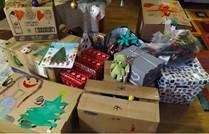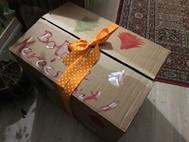Reverse Advent

Christmas is a time of giving and sharing with the people that we love and care for but also with those around us that are more vulnerable and in need of support. Traditionally, during the Advent Season, the willigness to donate and help is rising manyfold.
To count the days of Advent in anticipation of Christmas, many children receive an Advent Calendar that features 24 little doors, one for each day of December leading up to Christmas Eve. Each day, a door is opened to reveal an image, a small gift or a little chocolate.
In the Hungarian town Székesfehérvár, located halfway between Budapest and the famous Lake Balaton, the idea was born to combine the Christmas spirit of donating with the tradition of the Advent Calendar. In Summer 2019, after joining the 2LIFES project and kick-starting their 2LIFES stakeholder community for reuse and recycling, employees of the local Central Transdanubian Regional Innovation Agency (KDRIÜ) came up with the concept of ‘Reverse Advent’. Already in December 2019, the Agency implemented its first Reverse Advent pilot initiative in cooperation with the local reuse and recycling NGO Ki? -Ti & Mi.
Donating 24 reuseable items

The essence of the Reverse Advent initiative is that instead of receiving an Advent Calendar, one family is donating 24 used items in good condition to a family in need. On 1st December, each donor family receives an empty box from the Agency and then fills it each day with used toys, books, clothes, tools and more potential Christmas presents. During the Advent Season, the Agency reserves a room where the boxes can be stored before giving them to the receiving families that cannot afford Christmas presents.
Dr. Ákos Szépvölgyi, Managing Director of the Central Transdanubian Regional Innovation Agency, underlined: „The media often say that reuse and recycling are very difficult. With the Reverse Advent, we wanted to achieve environmental and social impact whilst showing at the same time that it can be very simple yet effective. We are also very keen to involve children in the collection for these Advent Boxes so they learn how to give a new life to used items such as toys and books.”
The Reverse Advent project is promoted together with other reuse initiatives through the webpage, social media and at local farmer markets. Moreover, the biggest municipalities in the reuse and recycling community help finding suitable donor families. The families in need are identified through direct referral or with the help of healths institutions where their children are being treated.
Collecting over 1200 Christmas presents in 2020

The pilot project has been very successful and raised a lot of interest. In the first Reverse Advent pilot, 10 donor families participated and collected 240 reuseable items for 10 families in need. Today, more than 50 families have already subscribed to the initiative and are scheduled to collect at least 1200 items during the 2020 Advent season.
Dr. Ákos Szépvölgyi is very happy with the progress of the initiative and says: „We consider this initiative as being potentially interesting to learn from, because it is very easy, very cheap and implemented during an important season where we start paying more attention to ourselves, our relationship, our environment and for decreasing social inequalities.”
The simple and effective Reverse Advent concept appeals already to other Hungarian regions and the European 2Lifes project partners who are keen to implement their own Reverse Advent in the next Christmas season.
In addition to a Christmas edition, the approach can be enlarged to a year-round collection of reuseable items such as the Re-Use Box. In Austria, where awareness and acceptance of reuse and repair initiative is already very high, the Reuse Shops complained about insufficient amounts of reuse goods available as they could sell significantly more of them. To address this issue, the Re-Use box has been introduced. It is similar to a moving box and can be produced by all waste management facilities or by operators of Reuse Shops. During the introduction phase, 40,000 boxes were produced and the availability of the new Re-Use boxes was widely advertised.
As a result, an additional 500 tonnes of useful items could be collected and sold in Reuse Shops. This not only made a significant contribution to waste avoidance, but also helped the socio-economic operators of the Reuse Shops to preserve jobs and create new ones. The good practice about the Re-Use Box collection system for small reusable items such as books, crockery, tools, toys, sports equipment and electrical appliances has been featured by the WINPOL project.
Conclusion
Reuse and repair initiatives are high on the political agenda and an important cornerstone of the European Green Deal. Next to the obvious environmental benefits, they offer opportunities for job creation as well new chances to people with difficulties and families in need. Good Practices from around Europe illustrate that reuse projects can be implemented in a simple and cost-effective way and many European regions and cities are interested in starting their own initiatives. The Reverse Advent initiative shows that starting reuse projects during Christmas time is indeed an ideal moment to raise awareness and build a re-use community.
For more inspiration and information about reuse initiatives, please see:
- Good practices of 2LIFES project
- Watch the 2LIFES video of Reverse Advent
- Key learnings of the EU Regions Week participatory lab on 'Reuse and Repair in a circular economy'
